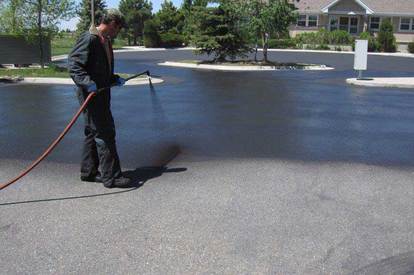Is It Better to Spray or Squeegee Sealer Onto Asphalt?
Posted on July 26, 2019 by Rafael Cantillo
Having new asphalt put down is an expensive process. Eventually, that asphalt will wear down and repairs will be needed. Potholes can be filled, for a while, but eventually, a more permanent solution will be needed. This means adding another layer of asphalt, and eventually stripping it all away and starting over. All of this adds up to big money. Although the effects of weather and wear are inevitable, sealcoating is a highly effective way of protecting your asphalt so you maximize the amount of time you have before all of those increasingly expensive procedures become necessary. In this post, we'll talk about the two types of sealcoat application, and examine which one is best for your job.
What is Sealant?
Before we can decide which method of sealant application is the best, we must first establish why we are putting it down in the first place. Asphalt has poor UV resistance and will begin to oxidize very quickly. Oxidation of pavement is a lot like oxidation of steel, also known as rust. As the pavement begins to oxidize, it becomes more brittle. Oxidized pavement will also be quicker to soak up water, which carries with it an increase in all of the forms of wear that water can cause.
The purpose of sealant is to put a layer of protection between the asphalt, the damaging UV rays, and the weathering effects that exposure can cause. Think of applying sealant like applying a layer of paint or clear coat to your bare steel projects to help prevent them from rusting. As asphalt paving is an expensive process, you can quickly see the benefit of applying sealcoat to protect it.
How Does Spraying Work?
If sealcoating is like paint on bare metal, then sealcoat spraying is like a giant paint sprayer. When applying sealcoating using the spray method, the crew will show up with a tank trunk, or perhaps a smaller tow-behind tank. High pressure is then applied to the tank which sprays out the sealant onto the surface of the pavement.
This method is quick and makes it easy to achieve an even result with minimal manual interference.
How Does Squeegeeing Work?
Most people probably know the squeegee as that thing that quickly dries a surface by pushing all of the liquid away. Someone who has taken certain shop classes will recognize it as a tool that allows you to press a filler into an uneven surface, creating an even surface. Auto body technicians, for example, use squeegees to apply body filler to smooth out dents. It is this use of the tool that is applicable to sealcoating.
The sealcoat is placed onto the asphalt surface and then the crew, either manually, or with a machine, use squeegees to force the liquid into the surface of the asphalt, providing significantly deeper coverage than the surface level application of the sprayer.
This method takes a little bit more work to apply and to get an even result but provides better protection.
So, Which is Better?
Earlier, we compared sealcoating to applying a coat of paint in order to prevent rust. Given that comparison, it may seem that spraying it on is the better option. It's faster, cheaper, and that's the exact process that it used to apply the paint that protects even the most expensive cars. So, spraying is clearly the better option, right?
Well, not so fast. The comparison to steel and rust sort of falls apart at this point. Steel is a nice, smooth, flat surface. You can easily spray on a few coats of paint and provide excellent coverage to all of its, nonexistent, nooks and crannies. This is not the case with asphalt. Asphalt is very thick, much more porous than steel, and filled with significantly more of those nooks and crannies that don't exist in steel. The squeegee process may take longer, and be a little more expensive, but it will force the sealant into all of those cracks and crevices. It will provide a deeper, more 3-dimensional coverage than sprayed sealant is able to.
The benefits of squeegee application do not stop at the practical. Not only will your asphalt be protected better, but it will look better as well. This is because forcing the sealant into all of those 3-dimensional spaces results in a much smoother finished product than you would be able to get with a sprayer.
For these reasons, Empire Parking Lot Services strongly suggest the squeegee process. The only exception to this recommendation is if time is an issue. If, for some reason, the project must be done quicker than squeegeeing would allow for, then spray coating becomes the better option.
What to Expect
Some things remain the same regardless of the type of sealcoating method that you choose. A professional service company will always clearly barricade off the area to be worked on before getting to work. Before the sealcoating process can begin, your parking lot will be cleaned thoroughly. This means blowing away any debris and then using high powered brushes and blowers to leave a surface that will not interfere with the sealcoating and prevent it from doing its job. After the job is finished, the crew will clean up any mess that they made.
Conclusion
Sealcoating isn't a permanent solution. It will not provide 100% protection that fully prevents any exposure from happening to the pavement. The sealant itself will also wear away over time, and should be reapplied regularly. But it is an important, and indeed necessary, step in your asphalt maintenance routine.
If your asphalt parking lot is in need of a fresh sealcoating, please feel free to give us a call at 714-633-0300. We are a reputable company that will provide you a quality sealcoating experience, along with the expertise to answer any questions you may have about the process. We'll also be more than happy to discuss any other questions or concerns you may have about maintenance procedures for prolonging the life of your asphalt.





Comments